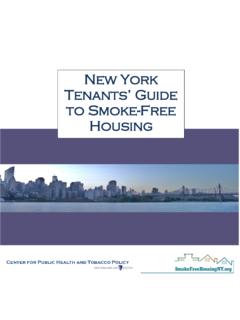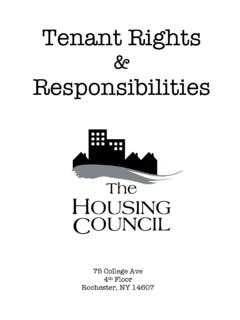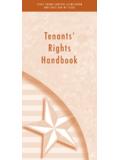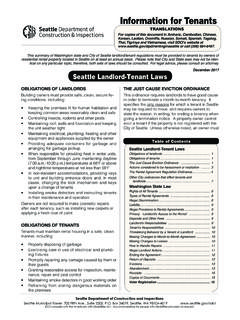Transcription of A 2011 Alberta Guide to the Law LANDLORDS & …
1 Type of law: CIVIL LAW. A 2011 Alberta Guide to the Law LANDLORDS &. TENANTS. Student Legal Services of Edmonton COPYRIGHT & DISCLAIMER. GENERAL. All information is provided for general knowledge purposes only and is not meant as a replacement for professional legal advice. If you have a personal legal question that requires legal advice, please consult a lawyer. COPYRIGHT. Copyright 2015, Student Legal Services of Edmonton. All rights reserved. Copying any material, in whole or in part, is prohibited unless prior consent has been obtained. Some material may be subject to copyright from an outside source and thus there may be different restrictions on the reproduction of this material.
2 LIMITATION OF LIABILITY. Student Legal Services of Edmonton is not liable for any loss or damage caused by an individual's reliance on information or material obtained from Student Legal Services of Edmonton. By accessing the information, individuals agree that any usage is at their own risk. INFORMATION AND OPINIONS. In some instances, information obtained by Student Legal Services may have been provided by outside sources. Even with the high standards set by Student Legal Services of Edmonton, we accept no responsibility for the accuracy and reliability of the material. Opinions and Informations provided by third parties does not represent that of Student Legal Services of Edmonton.
3 IMAGES. Icons made by Freepik from Infographics sourced from Piktochart from LANDLORD AND tenant . RESIDENTIAL PREMISES DEFINITION ..1. THE LANDLORD ..1. THE tenant ..1. THE TENANCY AGREEMENT ..1. General Requirements ..2. Types of Tenancy Agreements ..2. Periodic Tenancy ..2. Fixed Term Tenancy ..2. Responsibility for Rent ..2. WHEN THE tenant MOVES IN ..3. Availability of Premises ..3. Habitability of Premises ..3. Copy of Agreement ..4. Promises in Writing ..4. INSPECTION REPORTS ..4. Requirements ..4. Inspection Reports with the tenant ..5. Inspection Reports without the tenant ..5. If the Landlord Does Not Do an Inspection ..5. SECURITY DEPOSITS ..5. Security Deposits and Damage Deposits.
4 5. Maximum Amount ..6. Beyond Normal Wear and Time Limits ..6. LANDLORD'S OBLIGATIONS ..6. Peaceful Enjoyment ..6. Entry of Premises ..7. Changing the Locks ..7. Duty to Repair ..7. Common Areas ..7. Increasing the Rent ..7. Landlord's Address: Notice to tenant ..8. New LANDLORDS ..8. tenant 'S OBLIGATIONS ..8. Abiding by the Agreement ..8. Changing the Locks ..9. Paying the Rent on Time ..9. Penalties for Late Payment ..9. Damage to the Premises ..9. SUBLETTING .. 10. Definition .. 10. Landlord's 10. Time Limit for Landlord's 11. Responsibility for Rent .. 11. TERMINATION OF TENANCIES .. 11. Honouring a Tenancy for Fixed Terms .. 11. Substantial Breach .. 12. Notice of Objection.
5 12. Rent Owing .. 13. Assault, Threats of Assault, or Damage .. 13. Reasons Permitting the Landlord to End the Tenancy .. 13. Time Limits .. 14. Employees .. 14. Other Requirements .. 14. Reasons a Landlord Cannot End a Tenancy .. 15. Overholding tenant .. 15. tenant LEAVING .. 15. Proper Notice .. 15. Time Limits .. 16. Remaining Tenants .. 16. ABANDONED GOODS .. 16. Repudiation of the Tenancy Agreement .. 17. CONDOMINIUMS .. 18. REMEDIES .. 19. General 19. The Residential Tenancy Dispute Resolution Service .. 19. Mediation .. 19. Remedies through the Court .. 20. Remedies through Government Services .. 21. Limitation Period .. 21. COURT ACTIONS TAKEN BY TENANTS .. 21. Recovery of Security Deposit.
6 21. Breach of Tenancy 22. COURT ACTIONS TAKEN BY LANDLORDS .. 22. Recovery of Rent .. 22. Seizure by Civil Enforcement Agency .. 23. Security Deposit .. 23. Other Remedies .. 23. WHERE CAN I GO FOR HELP OR MORE INFORMATION? .. 24. LANDLORD & TENANTS. Landlord and tenant law is the law that deals with the renting of houses and apartments, and the legislation for this law in Alberta is the Residential Tenancies Act. RESIDENTIAL PREMISES: The Residential Tenancies Act applies to Residential Premises , which includes most places that people live in and call home, such as apartments, houses, or self-contained rooms that are rented. Other forms of accommodation, such as nursing homes, hotels, mobile homes, social care facilities, seniors homes, university dormitories, rooms in a house where the landlord lives, and commercial properties, are not considered Residential Premises.
7 Persons who rent a condominium should see the section on Condominiums below. THE LANDLORD. A landlord is defined in the Residential Tenancies Act as the owner of the rented premises, the property manager of the rented premises, or any other person who has the job of deciding whether or not people will be allowed to become tenants. 1. Discrimination by the Landlord A landlord is not allowed to discriminate against tenants on the grounds of race, religious beliefs, colour, sex, marital status, ancestry, place of origin, physical characteristics, sexual orientation, or source of income as long as it is a lawful source. (In general, age is not a protected ground in the area of tenancy).
8 Discrimination complaints are directed to the Alberta Human Rights Commission Office. (Please see the Student Legal Services pamphlet on Human Rights & Discrimination for more information.). THE tenant . Under the Residential Tenancies Act, a tenant is someone who is renting property under an agreement with the landlord or someone who lives with the renter with authorization from the landlord. The definition of tenant also includes anyone who is renting from a previous tenant under a sublease or by assignment . The heirs of a tenant may also have tenant status. THE TENANCY AGREEMENT. 1. General Information The landlord/ tenant relationship begins when the landlord agrees to rent the premises to the 1.
9 tenant . An agreement can be written or verbal, but a written agreement is better because it is evidence of the agreement. A standard tenancy agreement form may be obtained from the Landlord and tenant Advisory Board. Generally, the terms of the agreement may not be changed after it has been made until the end date of the rental agreement, unless both the tenant and the landlord agree to make changes. Tenants cannot agree to waive any rights given to them by the Residential Tenancies Act. 2. Requirements A valid tenancy agreement must include the following: a. The names of the parties. A landlord may also require the names of others who are living as occupants, such as spouses and children.
10 B. A description (address) of the premises to be rented. c. The date the tenancy agreement is to start, the amount of rent to be paid, and all other terms to which the parties have agreed. If the agreement does not contain some or all of these things, it may be an invalid contract. If a term of the tenancy agreement contradicts the Residential Tenancies Act, the Act overrides that term. The rest of the agreement, however, is still valid and binding. 3. Types of Tenancy Agreements There are two types of tenancy agreements: a. Periodic Tenancy A periodic tenancy is one that does not end on a previously agreed fixed date. An agreement is periodic if there is no end date in the tenancy agreement.




